HOW TO IDENTIFY A RIP CURRENT AT THE BEACH
While it may look like perfect conditions down by the water, beneath the water there are hidden dangers swimmers may not be aware of. Many people have no idea what a rip is and how to identify it. Some rips can become extremely dangerous when the tide changes.
Here is everything you need to know about rips and strategies to use if you find yourself in a current.
WHAT IS A RIP CURRENT?
According to Surf Life Saving Australia, most Australians don't know how to spot a rip, with two out of three people getting it wrong.
A rip is a very strong and narrow current that pulls water back out to sea. They look relatively calm between the white breaking waves, but dark channels can actually indicate fast-moving currents.
In general, most rips that form are low energy, and are usually found between sandbars on windy days. When there is a sudden change in weather conditions, these rips can power up and become high energy.
Some rips are permanently fixed to a specific location and are therefore more predictable and easier to keep an eye on, but nonetheless dangerous. The most famous example of this is Bondi Beach's Backpacker Express in Sydney. Fixed rips tend to form near headlands, groynes, and jetties.
HOW TO SPOT A RIP CURRENT
Rips can be complex, and change shape and location quickly, making them difficult to see. There are several telltale signs to identify a rip.
Dark water in a channel means that there is deep water, indicating that a rip has dragged water back out to sea with enough force to carve out the sandbank.
The flow in these dark channels is a one-way-only ride, so this area won't have breaking waves. For inexperienced swimmers, this may seem to be the ideal spot to head to avoid a wipeout, but it is not.
In calmer waters, look out for spots with a rippled surface where currents are converging. There could be a rip forming below.
Another good indication of a rip is the presence of anything floating out to sea or sandy water flowing out beyond the waves.
Rips usually don’t always show all of these signs, so be aware that spots that seem calm can change suddenly.
WHAT TO DO WHEN YOU ARE STUCK IN A RIP CURRENT
In most cases, rips don’t last very long and usually break up not too far from the beach, so stay afloat and keep calm. A rip won't pull you under, but it will drag you away from shore.
If you do get caught in a rip, the common advice is to simply "go with the flow" and let it take you out, as it takes too much effort to fight against it. If there are lifeguards on duty, signal immediately by waving an arm in the air and calling for help.
Stronger swimmers can attempt to swim parallel to the beach to get out of the current and back to shore.
WHAT TO DO IF YOU SEE SOMEONE IN A RIP CURRENT
If there is noone patrolling the water and you see someone in a rip, before you jump in consider your own safety. Make sure you are a competent swimmer and not getting yourself stuck in a rip alongside them. People drown every year trying to save people in rips.
First attempt to guide them out of the rip from the shore by calling out, providing hand signals or even flotation devices if they are available.
If you feel confident enough, swim out to them but keep your distance. Avoid grabbing the person as they may be scared and could attempt to hold you under. Instead, call out and point sideways to help them swim across the rip. Render assistance on the shore and call emergency services if required.
It is a good idea to understand the nature of rips and the power of the water before swimming at a beach. Avoiding rips could be the difference between life and death.
Download the Deckee app from the App Store or Google Play for free to stay safe on the water. Check the marine weather forecast, track your boat trips, inspect Aids to Navigation, and more. Join our community of passionate boaters to find and share your favourite anchorages, marinas, or fishing spots.



